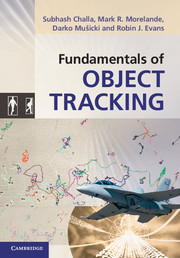Book contents
- Frontmatter
- Contents
- Preface
- 1 Introduction to object tracking
- 2 Filtering theory and non-maneuvering object tracking
- 3 Maneuvering object tracking
- 4 Single-object tracking in clutter
- 5 Single- and multiple-object tracking in clutter: object-existence-based approach
- 6 Multiple-object tracking in clutter: random-set-based approach
- 7 Bayesian smoothing algorithms for object tracking
- 8 Object tracking with time-delayed, out-of-sequence measurements
- 9 Practical object tracking
- Appendix A Mathematical and statistical preliminaries
- Appendix B Finite set statistics (FISST)
- Appendix C Pseudo-functions in object tracking
- References
- Index
5 - Single- and multiple-object tracking in clutter: object-existence-based approach
Published online by Cambridge University Press: 07 September 2011
- Frontmatter
- Contents
- Preface
- 1 Introduction to object tracking
- 2 Filtering theory and non-maneuvering object tracking
- 3 Maneuvering object tracking
- 4 Single-object tracking in clutter
- 5 Single- and multiple-object tracking in clutter: object-existence-based approach
- 6 Multiple-object tracking in clutter: random-set-based approach
- 7 Bayesian smoothing algorithms for object tracking
- 8 Object tracking with time-delayed, out-of-sequence measurements
- 9 Practical object tracking
- Appendix A Mathematical and statistical preliminaries
- Appendix B Finite set statistics (FISST)
- Appendix C Pseudo-functions in object tracking
- References
- Index
Summary
In many practical situations, the number and existence of objects that are supposed to be tracked are a priori unknown. This information is an important part of the tracking output. In this chapter we include the object existence in the track state. As in previous chapters, the track state pdf propagates between scans as a Markov process, and is updated using the Bayes formula.
Object existence is particularly important in the cluttered environment, when the origin of each measurement is a priori unknown. This chapter reveals the close relationship (generalization/specialization) of a number of object-existence-based target tracking filters, which have a common derivation and common update cycle.
Some of the algorithms mentioned here also appear in other chapters of this book. These include probabilistic data association (PDA) (Section 4.3), integrated PDA (IPDA) (Sections 5.4.4 and 6.4.4) and joint IPDA (JIPDA) (Section 6.4.5). The derivations of this chapter follow a different track, and the results are more general as they also cater for non-homogeneous clutter.
Introduction
Object tracking aims to estimate the states of a (usually moving) unknown number of objects, using measurements received from sensors, and based on assumptions and models of the objects and measurements.
The object tracking algorithms presented in this chapter are based on the following assumptions, unless stated otherwise:
Object:
– There are zero or more objects in the surveillance area. The number and the position of the objects are a priori unknown.
[…]
- Type
- Chapter
- Information
- Fundamentals of Object Tracking , pp. 133 - 222Publisher: Cambridge University PressPrint publication year: 2011

